Reactive bass traps really work when properly designed and installed, targeting specific low frequencies that cause muddiness, boominess, or uneven bass response. They use resonant elements like Helmholtz or membrane chambers to absorb energy dynamically, offering tailored acoustic improvements. Their effectiveness depends on room size, placement, and construction quality. If you want to understand how to optimize them and see how they can transform your space, there’s more to explore.
Key Takeaways
- Reactive bass traps are designed to target specific low frequencies using resonant components for effective bass absorption.
- Proper placement, especially in corners and near walls, is crucial for their optimal performance.
- They can significantly improve bass clarity and reduce muddiness when correctly installed and tuned.
- Their effectiveness varies based on room size, shape, acoustic properties, and construction quality.
- While more expensive and complex than passive traps, they provide precise control over problematic bass resonances.
What Are Reactive Bass Traps and How Do They Differ From Other Treatments
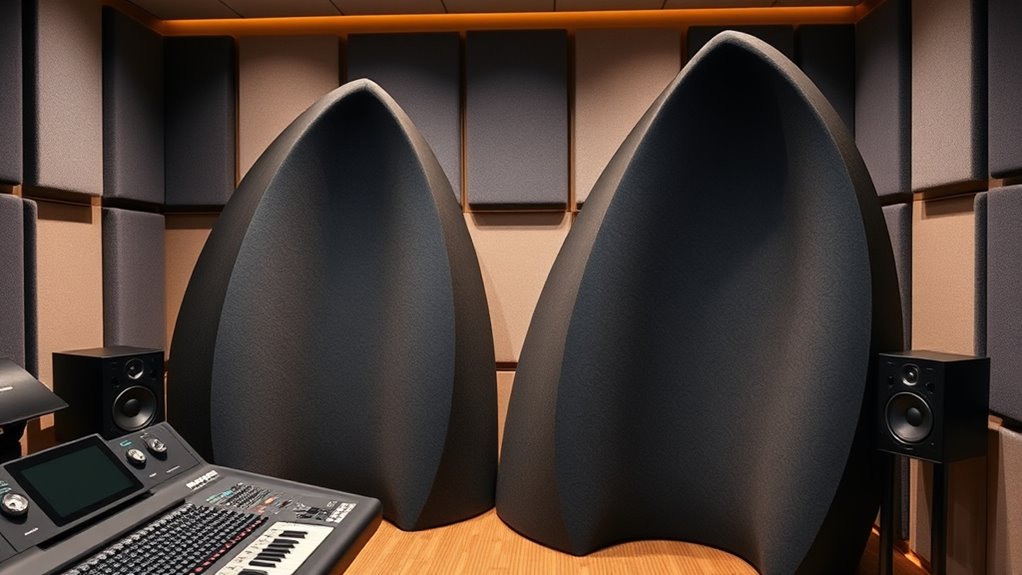
Reactive bass traps are specialized acoustic treatments designed to respond dynamically to low-frequency sounds, effectively controlling bass resonances in a room. Unlike broadband or porous absorbers that reduce sound across a wide frequency range, reactive traps target specific bass frequencies by exploiting their physical properties. They use movable or resonant elements that react to the energy of low bass notes, absorbing and dampening problematic resonances more efficiently. This focused response helps smooth out bass response and reduces muddiness or boominess. You’ll notice that reactive traps are often larger or more complex than typical foam panels, because they’re engineered to interact with low-frequency waves. They stand out because they adapt to sound pressure levels, offering a more precise solution for managing bass issues. Additionally, some Louisiana Civil Code components like targeted resonant chambers demonstrate how specific design features can significantly enhance low-frequency control, much like reactive bass traps precisely improve low-frequency response. Incorporating acoustic engineering principles into their design allows reactive traps to achieve their focused low-frequency control more effectively. In addition, the dynamic behavior of reactive traps enables them to adapt to varying sound environments, making them especially useful in versatile home theater setups.
The Physics Behind Reactive Bass Absorption
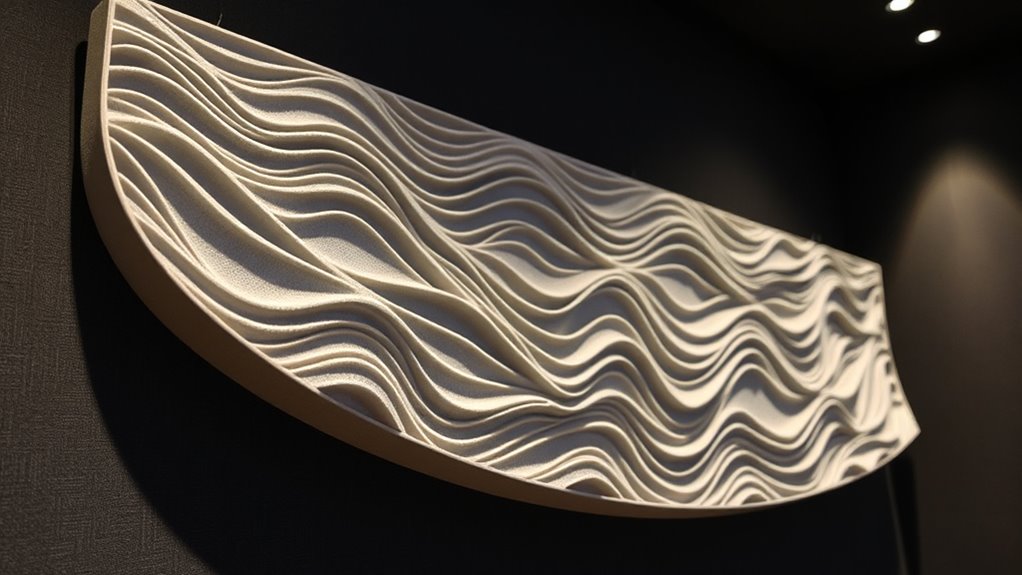
The physics behind reactive bass absorption relies on the way low-frequency sound waves interact with specially designed resonant structures. When sound waves reach a reactive bass trap, they cause the trap’s internal air or material to vibrate at specific frequencies. These vibrations absorb energy from the sound waves, reducing their amplitude. Basically, the trap acts like a tuned resonator, matching the frequency of problematic bass notes. As the sound wave hits the trap, it causes the air mass inside or the resonant material to oscillate out of phase with the incoming wave. This out-of-phase movement cancels out some of the sound energy, effectively dampening low-frequency vibrations before they can reflect or build up in the room. This process is fundamental to how reactive bass traps control bass resonance.
Types of Reactive Bass Traps and Their Construction
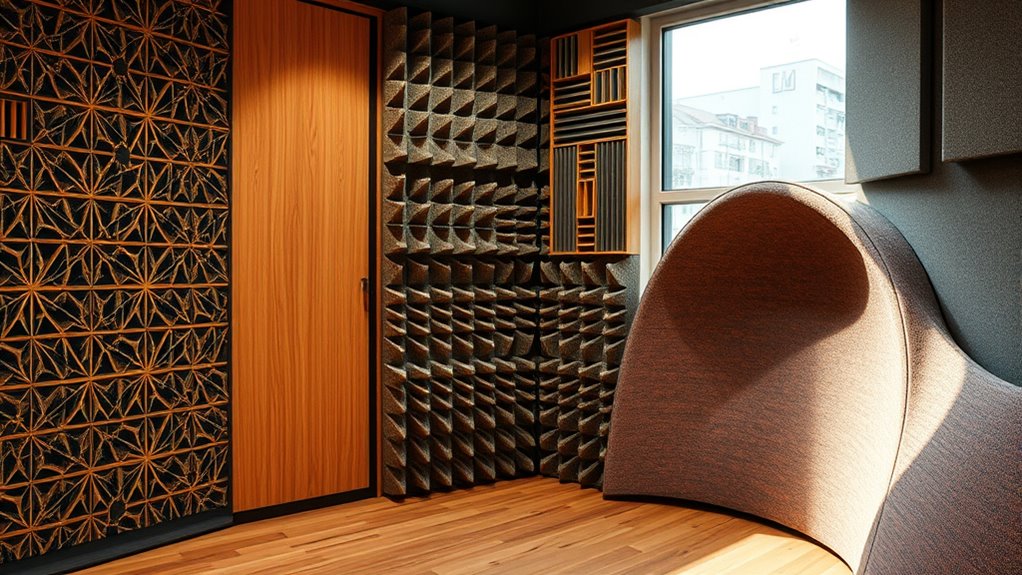
There are several common types of reactive bass traps, each designed with specific construction techniques to target low-frequency sound waves effectively. Helmholtz resonators are one popular type; they use a hollow chamber with a tuned opening to absorb specific bass frequencies. Membrane traps feature a stretched membrane that vibrates in response to low-frequency sound, dissipating energy as heat. Panel resonators involve a rigid panel attached to an air cavity, which resonates at particular frequencies to reduce bass buildup. Tube traps utilize long, resonant tubes or chambers that absorb or reflect specific low frequencies based on their dimensions. Each design requires precise construction, including carefully chosen materials and tuning, to ensure they target the desired bass range effectively and improve your room’s acoustic response.
Effectiveness of Reactive Bass Traps in Real-World Settings
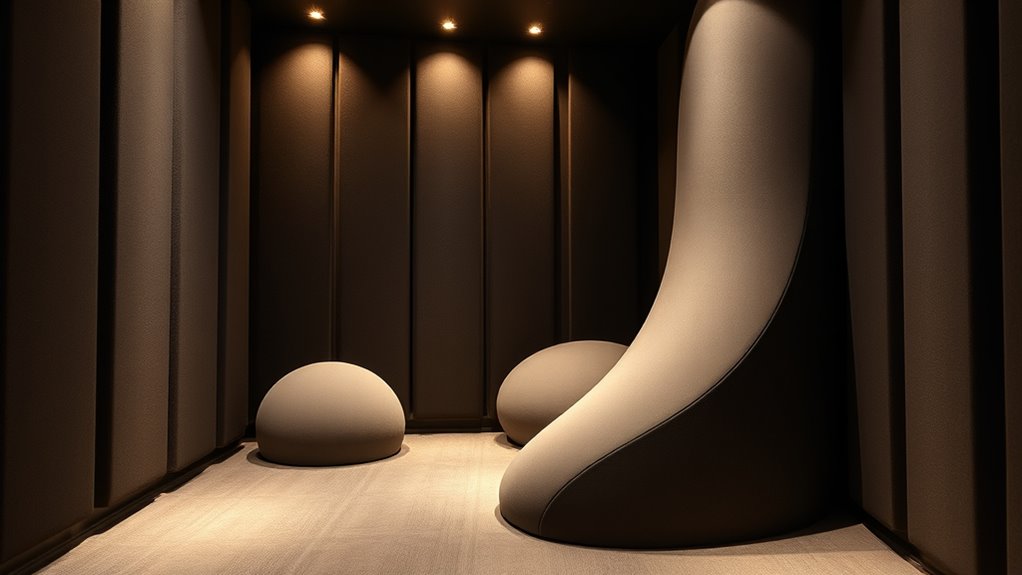
Reactive bass traps can significantly improve your room’s sound, but their effectiveness varies based on real-world conditions. Room size and shape influence how well they absorb low frequencies, so results may differ from those in controlled environments. Additionally, installation quality and placement play crucial roles in achieving the best acoustic improvements. Advances in automation technologies are also enabling more precise tuning and customization of acoustic treatments like bass traps.
Real-World Acoustic Improvements
While reactive bass traps are designed to improve low-frequency sound control, their effectiveness can vary markedly in real-world environments. You might notice a reduction in boominess and muddiness, especially in dedicated listening or recording spaces. In practice, these traps often enhance clarity and tighten bass response, making audio more accurate and balanced. Additionally, the room’s acoustic properties significantly influence how well these traps perform, as certain spaces may require additional treatments for optimal results. Proper placement is crucial, as room dimensions and furnishings can dramatically alter acoustic outcomes. However, results depend heavily on proper placement and room characteristics. In some cases, you’ll see significant improvements, while in others, the impact may be subtle. Factors like existing room dimensions, furnishings, and other acoustic treatments influence outcomes. Overall, reactive bass traps can deliver noticeable acoustic benefits when implemented correctly, but don’t expect miracle results without considering the specific challenges of your space. Proper placement and understanding room acoustics are essential for maximizing their effectiveness.
Room Size Impacts
How does room size influence the performance of reactive bass traps? Larger rooms tend to require more extensive trapping because low-frequency waves have more space to develop, making effective absorption trickier. Smaller spaces, however, see quicker results because sound waves bounce less and are easier to control. To illustrate, here’s how different room sizes impact effectiveness:
| Room Size | Bass Response | Trap Placement |
|---|---|---|
| Small (under 1500 sq ft) | Easier to tame bass | Close to corners needed |
| Medium (1500-3000 sq ft) | Moderate bass control | Strategic placement helps |
| Large (over 3000 sq ft) | Challenging bass management | Multiple traps essential |
In bigger rooms, reactive traps work but need careful placement and quantity to be effective. Additionally, room acoustics play a crucial role in optimizing trap performance.
Installation Variability
The effectiveness of reactive bass traps in real-world settings often varies based on installation methods and environment. If you install them improperly, they may not perform as intended. Positioning is essential; placing traps in the wrong spots can limit their ability to absorb low-frequency energy. For example, installing them too far from walls or corners reduces their effectiveness. The room’s shape and furnishings also influence outcomes, as clutter and irregular surfaces can disrupt bass trapping. Additionally, the number of traps and their size matter—insufficient coverage won’t control bass issues. When you carefully plan placement, consider room geometry, and follow manufacturer recommendations, reactive bass traps can deliver better results. Otherwise, you risk wasting time and money on solutions that don’t improve your sound environment. Proper installation techniques and understanding room acoustics are crucial to maximizing their performance. Taking into account room acoustics can help optimize placement and enhance the traps’ effectiveness.
Factors That Influence Performance and Results
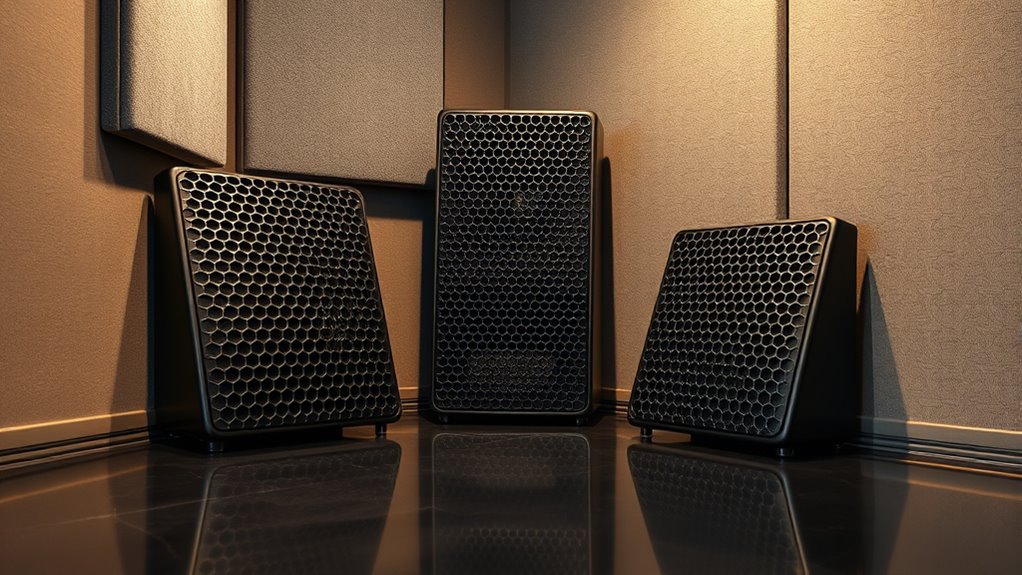
Several key factors can profoundly impact the effectiveness of reactive bass traps in your space. First, room size and shape markedly influence how bass frequencies behave and how well traps can absorb them. Larger or oddly shaped rooms might require multiple traps or different placement strategies. The positioning of the traps matters too; placing them at the right points—like corners or walls—maximizes their performance. Material quality and construction also play a role, as higher-quality materials absorb more bass without introducing unwanted reflections. Additionally, existing acoustic treatment, furniture, and room furnishings can alter how sound waves interact with the traps. For example, certain tuning modifications in related areas like the sound system setup can influence how effective bass traps are. Moreover, understanding the room acoustics helps optimize placement and performance of the traps. Effective bass trapping also depends on AI-driven analysis, which can provide insights into how sound behaves in your specific environment. A thorough understanding of sound wave behavior can further enhance trap placement and effectiveness. Finally, your listening or recording goals determine how aggressive or subtle your treatment needs to be. All these factors combine to shape the actual results you’ll experience.
Pros and Cons of Installing Reactive Bass Traps
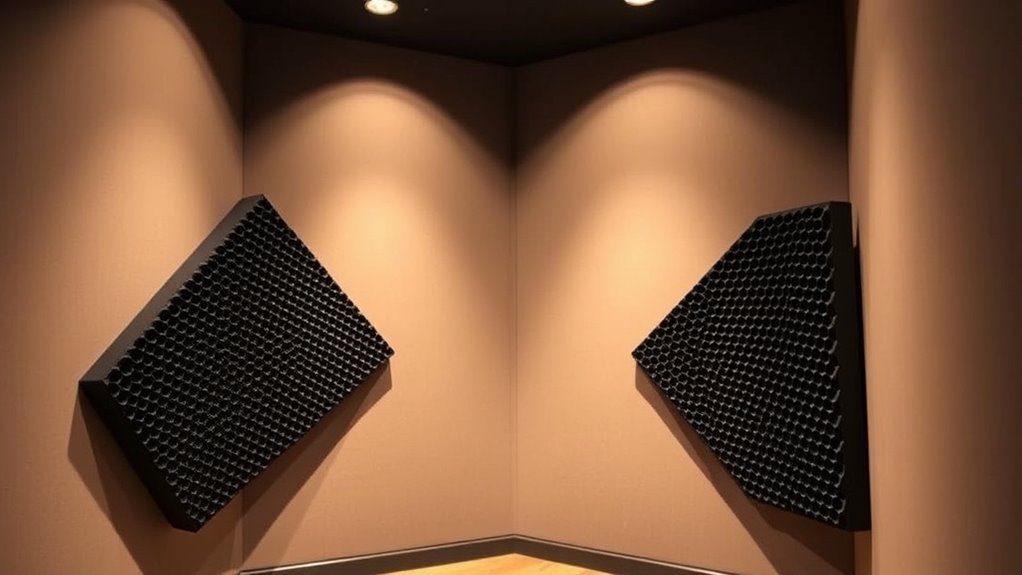
Installing reactive bass traps offers notable advantages but also comes with some drawbacks. On the plus side, they adapt to different sound frequencies, providing more effective bass management and improving your room’s overall acoustics. This dynamic response helps reduce muddiness and enhances clarity during recordings or listening sessions. However, reactive bass traps can be expensive and more complex to install compared to passive options. They often require precise placement and calibration, which might demand professional assistance. Additionally, their effectiveness depends on room size and shape; in some spaces, they may not deliver the desired results. While reactive bass traps can considerably improve sound quality, they may not be suitable for every budget or DIY enthusiast, and improper installation could limit their benefits. Vetted solutions are also available that can help optimize your acoustic setup effectively.
Are Reactive Bass Traps a Worthwhile Investment?
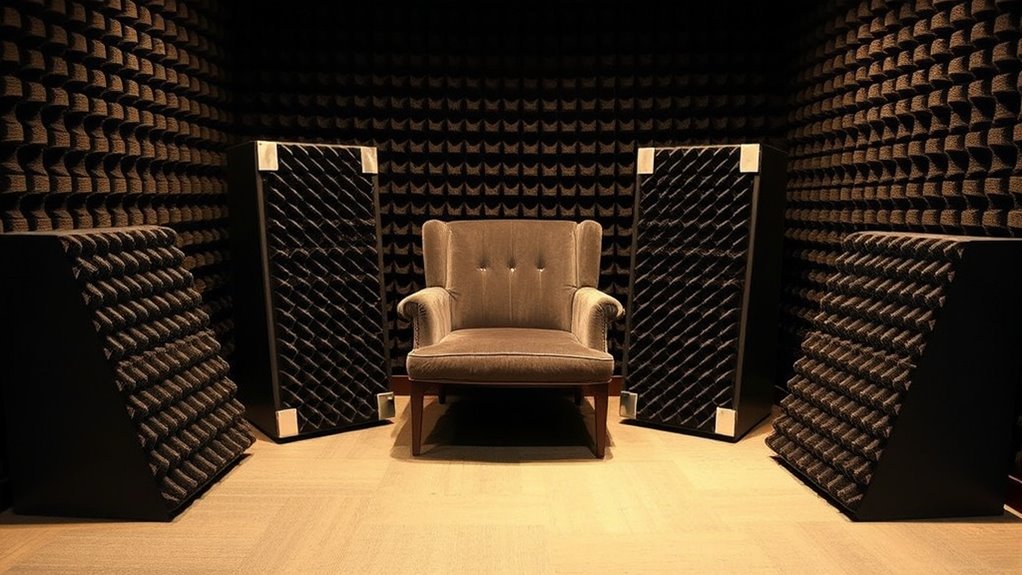
Reactive bass traps can be a worthwhile investment if you’re serious about achieving professional-quality sound in your space. They adapt dynamically to low-frequency energy, helping to reduce boominess and uneven bass response. If you’re working on mixing, recording, or simply want a more accurate listening environment, these traps can make a noticeable difference. While they tend to cost more than passive options, their ability to react and counteract problematic resonances can save you time and frustration in the long run. Additionally, selecting the right appliances connection retailer can ensure you get quality products and reliable service for your acoustic treatment needs. Considering the importance of proper storage for acoustic materials can further extend the effectiveness of your treatment. However, consider your room size, budget, and existing acoustic treatment before investing. If you’re committed to high-quality sound and want a tailored solution, reactive bass traps are generally a smart, effective choice that can considerably improve your listening experience.
Frequently Asked Questions
Can Reactive Bass Traps Be Customized for Specific Room Sizes?
You might wonder if reactive bass traps can be tailored to your room size. The good news is, yes, they can often be customized or chosen in different sizes to fit your space better. When you select the right size and type, reactive bass traps effectively target low-frequency issues specific to your room’s dimensions. Proper customization ensures ideal sound absorption, making your listening environment clearer and more balanced.
How Long Does It Take to See Results After Installation?
After installing reactive bass traps, you might wonder how long it takes to notice improvements. Typically, you’ll see results within a few hours to a couple of days, as the traps start absorbing and reducing bass resonances. However, the full effect can take up to a week, especially if your room is large or has complex acoustics. Patience assists in ensuring you experience the best possible sound quality.
Are Reactive Bass Traps Suitable for Home Studios or Only Professional Spaces?
Reactive bass traps are suitable for both home studios and professional spaces. You’ll benefit from their ability to target specific low-frequency issues, improving your sound quality regardless of your setup size. Whether you have a small room or a large studio, these traps adapt well and provide noticeable acoustic improvements. With proper placement, you’ll notice clearer bass and a more balanced sound, making them a valuable addition to any audio environment.
Do Reactive Bass Traps Require Ongoing Maintenance or Adjustments?
You might wonder if reactive bass traps need ongoing maintenance or adjustments. Generally, they don’t require much upkeep once installed correctly. However, you should periodically check for dust buildup or damage that could affect performance. If your room’s acoustics change considerably, minor adjustments might help optimize their effectiveness. Overall, with minimal care, reactive bass traps continue to work well over time, providing consistent acoustic benefits.
What Are the Signs That Reactive Bass Traps Are Not Working Effectively?
If you notice persistent bass issues despite installing reactive bass traps, they might not be working effectively. Signs include uneven sound, muddy bass response, or booming in certain areas. You might also experience a lack of clarity in your recordings or mixing environment. These issues suggest the traps aren’t absorbing or diffusing low frequencies properly, indicating it’s time to reassess placement or consider additional acoustic treatments to improve your room’s sound.
Conclusion
Think of reactive bass traps as the tuning pegs of your audio setup—they can fine-tune your sound and keep those muddy lows at bay. When I installed a set in my room, I noticed a clear difference, like dialing a radio station into perfect clarity. While they aren’t a magic fix for every space, with proper placement and understanding, reactive bass traps can transform your listening experience—making your bass as precise and powerful as you’ve always wanted.








